Professional Dental Cleanings
Just as important as providing your pet with food, water and regular physical exams is an annual, professional dental cleaning. Even with good regular at-home care, plaque and tartar build up, making professional cleanings essential. Untreated dental disease can cause significant discomfort and pain as well as permanent loss of teeth and gum tissue. Remember, your pet cannot tell you when he or she is in pain. Pets rely on their owners to take care of them and recognize when something is out of the ordinary.
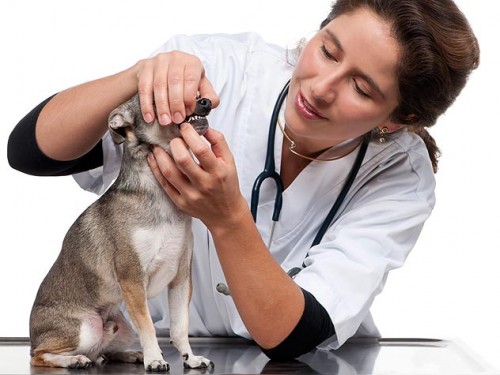
Your veterinarian will run pre-operative bloodwork to make sure your pet is healthy enough to undergo the anesthesia necessary for the procedure. While modern anesthesia is considered very safe, this is a precautionary measure to minimize any risks.
Your veterinarian might take dental radiographs (X-rays) to provide a better evaluation of the health of your pet’s teeth and jaw bone.
During the cleaning, the veterinary team will monitor your pet’s vital signs to ensure that they are normal. These vitals include respiration rate, heart rate, blood oxygen levels and body temperature.
Your pet’s teeth will be cleaned and polished with professional equipment that smoothes the tooth surface, removes tartar and plaque and polishes the teeth.
Antibitoics and/or pain medications may be prescribed depending on the extent of disease at the time of cleaning.
Once the dental cleaning is complete, your pet will be carefully brought out of anesthesia. Your veterinarian will ensure that your pet has recovered properly before releasing him or her to go home. Follow all home care instructions and be sure to check with your veterinarian immediately if you have any concerns.
Home Alone Barking
Within moments of Robin’s departure for work, Ruffles, her scruffy terrier mix, issues his usual succession of short, sharp, assertive barks, consistently apprising Robin’s neighbors of her comings and goings. The co-op board is considering eviction. Robin is at wits’ end.
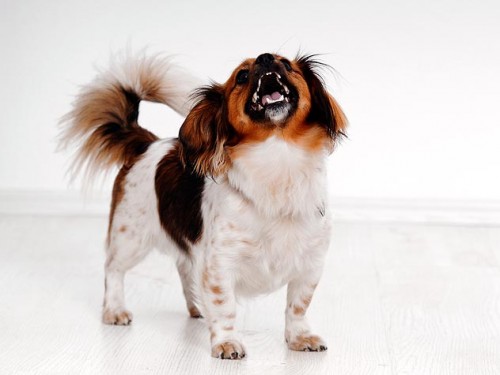
Dogs who bark when left alone fit several profiles. Separation anxiety sufferers are tightly bonded to their guardians and act as though their world has ended when they are apart. These dogs may also eliminate around the home, frantically chew on human possessions, and dig, chew, or propel themselves through doors or windows. To learn more about separation anxiety, refer to Don’t Leave Me This Way.
Some breeds (including most terriers) are born watchdogs, prone to sounding the alarm whenever a noise or movement catches their attention. Elimination of this tendency is unlikely in those born to bark; instead, they must be taught to limit their alerts to five or six barks and then settle down. Confining these “reactive barkers” to a dark, quiet part of the home when you are away promotes sleep instead of constant arousal.
Youngsters of any breed can be vocally challenging, unless exercised to the point of exhaustion. Try waking up early to ensure an hour of romping at the local dog park, throwing a ball until your arm is limp, or dropping Bowser off at doggie day care when morning exercise needs can’t be met.
Finally, there is the barker—like Ruffles—who seems intent on calling the family pack back together. Once family members leave the house, the fun stops. So he offers a vocal locator signal to draw them home. If they return while he’s barking, his efforts are rewarded.
Breaking the Cycle
If owner-absent barkers declare victory every time a family member returns—even if only to holler for quiet—how can this vicious cycle be broken? Start with exercises that reward the dog for being silent. On a day free of work commitments, go through your normal morning routine, but don’t stray far from the door once you’ve left home. If your dog is silent for a predetermined period of time, reenter and reward him. Begin with an easily obtainable goal—say, 10 to 30 seconds. When he barks, set the timer back to zero. It may take awhile to get that first silent success. Some dogs will improve faster when a marker indicates unwanted behavior; a sharp rap on the door with a metal object after a bark may speed things along. No shouting for quiet, though—most dogs prefer negative attention to none at all and may find your hollering rewarding.
Once you have garnered your first success, reenter the home, tell the dog “yes” or “good,” reward him, and go about your business. Keep all comings and goings low-key so he isn’t excessively revved up each time. Repeat the exercise numerous times, lengthening the time away with each success. If you have to restart the count more than a couple of times, you may be moving too far, too fast.
Some dogs will get wise to your presence on the other side of the door. Increase your distance after the first few repetitions to replicate departure. Instead of rapping to mark the unwanted behavior, you could employ a citronella-dispensing collar. This device interrupts each bark with a multi-sensory cue by combining the startling pssst of the mist exploding out of the container, the moist sensation, and the citronella smell. In a 1996 Journal of the American Animal Hospital Association article, Cornell University behaviorists Juarbe- Diaz and Houpt note that the citronella collar is twice as effective (88.9 compared to 44.4 percent) as the electronic shock collar, without the use of a painful stimulus. Some find that the use of the collar alone extinguishes barking proclivities. However, it is not suitable for separation anxiety cases, as these often demand a more extensive behavior modification protocol and possibly drug therapy as well.
Barking at Mail Carriers
I’ve never believed that dogs bark at mail carriers because they wear uniforms. I’ve yet to see a dog get upset over a marine, or a Girl Scout – so why mail carriers? The reason, I believe, is that dogs have no idea what a mail carrier is up to. A carrier drops mail into a box outside the front door. Since dogs seldom get mail, all they know is that this person brazenly walks up to their door, jiggles a box outside, and leaves without even a “Hey, boy, how ya’ doin’ today?”
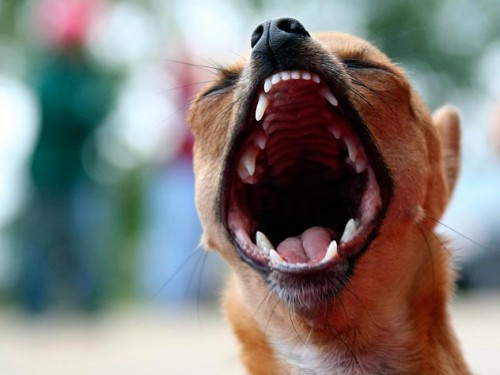
The ruckus begins the instant our carrier’s foot touches our block. All the dogs up the street begin to bark. As the carrier approaches our house, PeaJay begins with low, intermittent snarls. When the carrier is two doors away, the snarls are replaced with a staccato of barks that crack across the living room. Each series of barks ends with a howl that tapers off as his lungs collapse like spent balloons.
“Quiet,” I yell. “Quiet!”
For a moment he heeds me, just long enough to give me this odd look that I interpret loosely as, “Please, Master – fish gotta swim, birds gotta fly…”
By the time the carrier reaches my door, PeaJay’s state is frenzied. He wants to charge the window, but he’d have to leap on the couch to do that. But he’s not allowed on furniture, so he hurls his expletives at the door. When the carrier is a few doors past us, PeaJay calms down somewhat, pacing the living room as he grumbles and grunts, “…and you better keep on movin’!”
The ritual ends when the barking outside diminishes, signifying that the carrier has turned the corner. PeaJay, with a sense of accomplishment, stiff-legs it to the middle of the living room, executes a few turns in place and plops down heavily-asleep in a fraction of a second.
A variation of this scenario occurs wherever dogs cross paths with ‘appointed rounds.’ What really ticks off a dog is that a mail carrier never allows an opportunity for even one quick sniff of a pant leg. This, to a dog, is the height of bad manners. For to a canine, permitting a cursory sniff is akin to being handed a diary. The floating molecules snatched by his nose tell him if you’re friend or foe. A more thorough olfactory inspection reveals the species and gender of the pets you have, plus megabytes of other data that our inept proboscises can’t begin to fathom.
I’ve toyed with the idea of testing my theory by opening the door and introducing my dog to the carrier. I feel that after a few sniffs, PeaJay would wonder why he’s treated mail carriers with such contempt for all these years. But I hesitate…I fear that the intensity of the moment might cause PeaJay to skip the sniffing protocol, placing my theory, and the carrier, in an embarrassing position. With this in mind, I let sleeping dogs lie.
14 Ways to Stay Popular at the Dog Beach
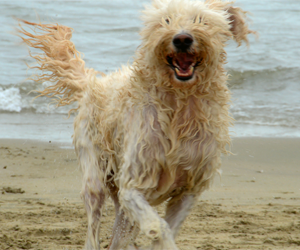
Forget Food. Do not bring your lunch — or any food at all — to a dog beach. You will be swarmed by dogs and probably lose your sandwich. Dogs can be worse than ants at a picnic.
Laugh. Do bring your sense of humor. You might get peed on or step in a pile of poo. Consider it good luck and move on.
Be realistic. If your dog is shy, don’t expect other dogs to respect that. Dogs will be dogs.
Don’t leave luck to your lady. Do not bring a female dog in heat to the beach unless you want trouble and puppies.
Walk like a man. If your male dog is not neutered, watch him closely — other dogs may want to challenge him.
Anger management. Do not bring an aggressive dog to the beach. If your dog gets into a scuffle, leave the beach immediately.
Poop patrol. Pick up after your dog, and nicely let other owners know if their dog has left a “present” on the beach.
Be prepared. Bring extra poop bags and towels, plenty of water, and a canine first-aid kit.
Adults only. Avoid bringing children to a dog beach, as they may be knocked over, scared, or injured.
Baywatch. Not just a great show from the 90s, but a practical activity too! Watch your dog at all times. This is not soggy-doggie daycare.
Sharing is caring. Don’t bring a toy to a dog beach unless you’re OK with other dogs playing with it and possibly losing it.
Bring your shades. Provide your dog with shade and lots of water on hot days.
Stay cool. If the sand burns your feet, it’s burning your dog’s paws, too. Run to the shore or carry your pooch.
Cover up. We aren’t talking about your clothes (although we do recommend staying more covered up then you would at the human beach.) Sunscreen for dogs? Yes! Apply sunscreen made specifically for dogs to their noses and ears. Rinse your dog off with fresh water after a day at the beach. Repeat!
Vigilance is Key to Preventing a Bite
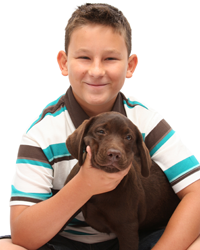
The AVMA estimates that of the children under the age of 18 who have been bitten: family dogs are responsible for 30% of the bites, while the neighbor’s dog is responsible for another 50% of the bites. Never assume because the child and dog know each other that they are fine together.
Whether you have a dog or not, take a minute to read over these helpful tips to preventing dog bites from Heidi Ganahl, CEO and founder of Camp Bow Wow. We all encounter dogs almost daily.These 10 tips might just save you a trip to the hospital. It might also save your dog’s life – many times an offending dog will be euthanized.
Pet Personalities. Dog owners should always understand (through training) their dog’s personality and limitations. Owners should not put dogs into situations where they feel anxious, nervous or afraid – this is a recipe for a dog bite encounter. Most aggression is fear-based and most bites are preventable if the owner takes some time to understand their dog.
Pets and Socialization. Socialize your pet at early stages in his development. This will allow your pet to feel at ease around people and other animals in social settings. Socializing your dog can have a tremendous effect on his interactions both at home and in public. Newly socialized dogs become calmer, friendly, affectionate, and can adapt better to a new environment.
Training Techniques. Train your dog or hire a professional to do so. Basic commands such as “Sit” and “Stay” help dogs understand what is expected of them. Training can also be incorporated into fun activities that establish the owner as an authoritative figure, yet strengthen the bond between owner and dog as companion and friend.
Space and Body Language. Respect the dog’s space. Never stand over a dog or stare at the dog while hovering above him. This is a direct threat in the dog’s language and may provoke a bite because the dog is afraid or intimidated.
Pets and Children. Children are the most common victims of dog bites. Never leave a child under 10 years old alone with a dog, no matter how much you trust your four-legged friend. Children should always ask before petting a dog, and parents and dog owners should observe and supervise the interaction between dog and child with even the most child-friendly dog.
Children and Aggressive Behavior. Children should never get in a dogs face or grab the dog in an aggressive way. Dogs tend to give warnings when they are uncomfortable and may bite in response. In most cases, children aren’t able to pick up on these signals and can easily get hurt.
Dogs in Chains. Never chain or tether your dog in the backyard or any other area. Dogs who are chained up feel increased levels of stress and protectiveness. A dog that is confined and feels threatened will defend himself and is more likely to bite.
Security in Public. Pet owners should always use a leash to ensure that they are able to control their dog in public settings. If the pet becomes excited or anxious for any reason, pet owners should draw him near and gently pat his head or rub his fur to calm him down.
Security at Home. If your home has a fenced yard, make sure gates are always secure. This will prevent Fido from running off into public spaces and interacting with others without your supervision.
Pet Health. A healthy pet is a happy pet. Make sure that your dog visits a veterinarian annually, receives proper exercise, and is vaccinated against rabies and preventable diseases. Remember, how your dog feels affects how he behaves.
View the DogChannel behavior center for more signs and corrective actions for dog’s that bite. More>>
The following are tips provided by the CDC on what to do if you or your child is bitten:
Rinse the bite area with soapy water.
Elevate limb(s) that have been bitten.
Apply antiseptic lotion or cream. Watch the area for signs of infection for several days after the incident.
For deeper bites or puncture wounds, apply pressure with a clean bandage or towel to stop the bleeding. Then wash the wound, dry it and cover with a sterile dressing. Don’t use tape or butterfly bandages to close the wound.
It’s a good idea to call your child’s physician because a bite could require antibiotics or a tetanus shot. The doctor also can help you to report the incident.
If your child is bitten severely, call 9-1-1 or go to the emergency room.
When going to the emergency room, advise the personnel of:
a. your tetanus vaccination status
b. vaccine status of the dog
c. who the dog owner is; and
d. if the dog has bitten before
Remember, vigilance is key in any situation where your dog is around other people and animals. Never assume you know what your dog is going to do – that’s like assuming you know what the person next to you is thinking or going to do – it’s a recipe for disaster.
Dog Peeing When Excited
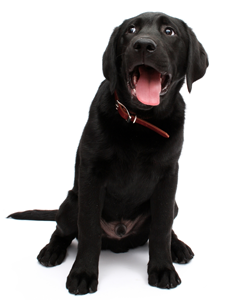
It is fairly common in young puppies who have less control over their bladder and are easily excited, though it usually goes away as the dog matures. Some dogs, however, continue this habit into adulthood. This behavior tends to be more common in female pups, but it can happen with males, too.
Why dogs pee when excited
When a puppy becomes overexcited, or when something frightens her, it’s normal for the pup to release a few drops of urine. Not all puppies do this, but many do. It happens because overexcitement or fear may cause the pup to momentarily lose control of the muscles that close the urinary bladder, which allows a small amount of urine to escape.
This is a physiological response to excitement and is not under the pup’s control. She might not even realize it’s happening until she feels a sensation of wetness.
Why this dog behavior is a problem
Cleaning up puddles every time you greet your dog can be frustrating and distressing to owners. The first reaction is often to scold a dog for the behavior, but it is not the dog’s fault. Punishing a dog for this behavior is useless and cruel, because the dog cannot control the leakage.
Scolding or showing disapproval can make the dog more anxious and cause the problem to get worse – sometimes turning a temporary age or health-related behavior into a long-term nervous habit.
How to keep your dog from peeing when excited
Reduce the initial excitement. The most common trigger for urination while greeting is loved ones arriving home after being gone for several hours. To reduce the dog’s excitement, walk into your house without greeting her. Put down your purse or other items you’re carrying and put your coat away. Delay greeting her until about five minutes after you’ve arrived home.
Keep greetings low key. Speak quietly and calmly when you greet your dog. Don’t immediately bend down to pet her, as “looming over” a dog in that way can trigger them to urinate. Instead of reaching for her, just put your hand where she can come to it for petting. Pet her under the chin, not on top of the head. Teach your visitors to do the same.
Greet outdoors. If your dog tends to pee when you first say hello to her, say hello outdoors. This way the dog will be urinating where there’s no need to mop it up. That will reduce your own anxiety about the possibility of a wet greeting and you’ll relax a bit – which can help reduce any anxiety your dog might have learned to feel about greeting time.
Health check. Though usually outgrown by six or seven months of age, this behavior can linger into adulthood. Sometimes health issues, such as urinary tract infections, can cause delayed bladder control, so if your dog is over five months old and still piddling when petted, let your veterinarian know. If it’s a health problem, it needs to be treated medically. Most often, though, there are no health issues causing the problem – it’s just a case of too much excitement.
Peanut, The World’s Ugliest Dog Gets a Makeover
Like the winners of the Miss America contest or the Nobel Prize, the pageantries and celebrations of the World’s Ugliest Dog did not end when he stepped off the stage.
The two-year-old Chihuahua-Shih Tzu mix named Peanut won the big trophy and the admiration of his peers at the Marin-Sonoma Fair in Petaluma, CA last week, but that was only the beginning of his journey.
Last night, Peanut and his owner Holly Chandler were guests on Jimmy Kimmel Live. Kimmel, who was familiar with the tough road that Peanut, a rescue dog and burn victim has traveled, wanted to make sure he could give the little dog an experience that he would not soon forget: a makeover.
Kimmel’s initial take on Peanut was that “he’s either the World’s Ugliest Dog or the World’s Prettiest Rat.”
In the montage, Peanut is put through all the essentials of a makeover: grooming, accessories and wardrobe. When Kimmel finally brings him on stage, dressed in a multicolored polka dot bowtie and his hair expertly combed, Peanut looks like a star.
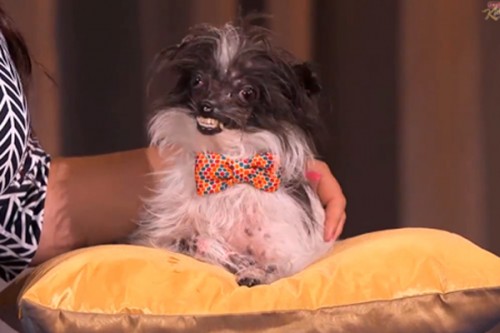
He looks beautiful, doesn’t he?
There isn’t much you can change about Peanut to make him into a different dog. A bowtie and combing doesn’t change much about the pain and suffering this friendly dog went through to get to where he is.
A makeover is a nice gift, but truthfully Peanut should be proud to be who he is. You do you, Peanut. We love you just the way you are.
Peanut and his human live in Greenville, South Carolina. They entered Peanut in the contest in order to raise awareness around the subject of animal abuse.





